Material Manipulations
08 Jun - 08 Sep 2024
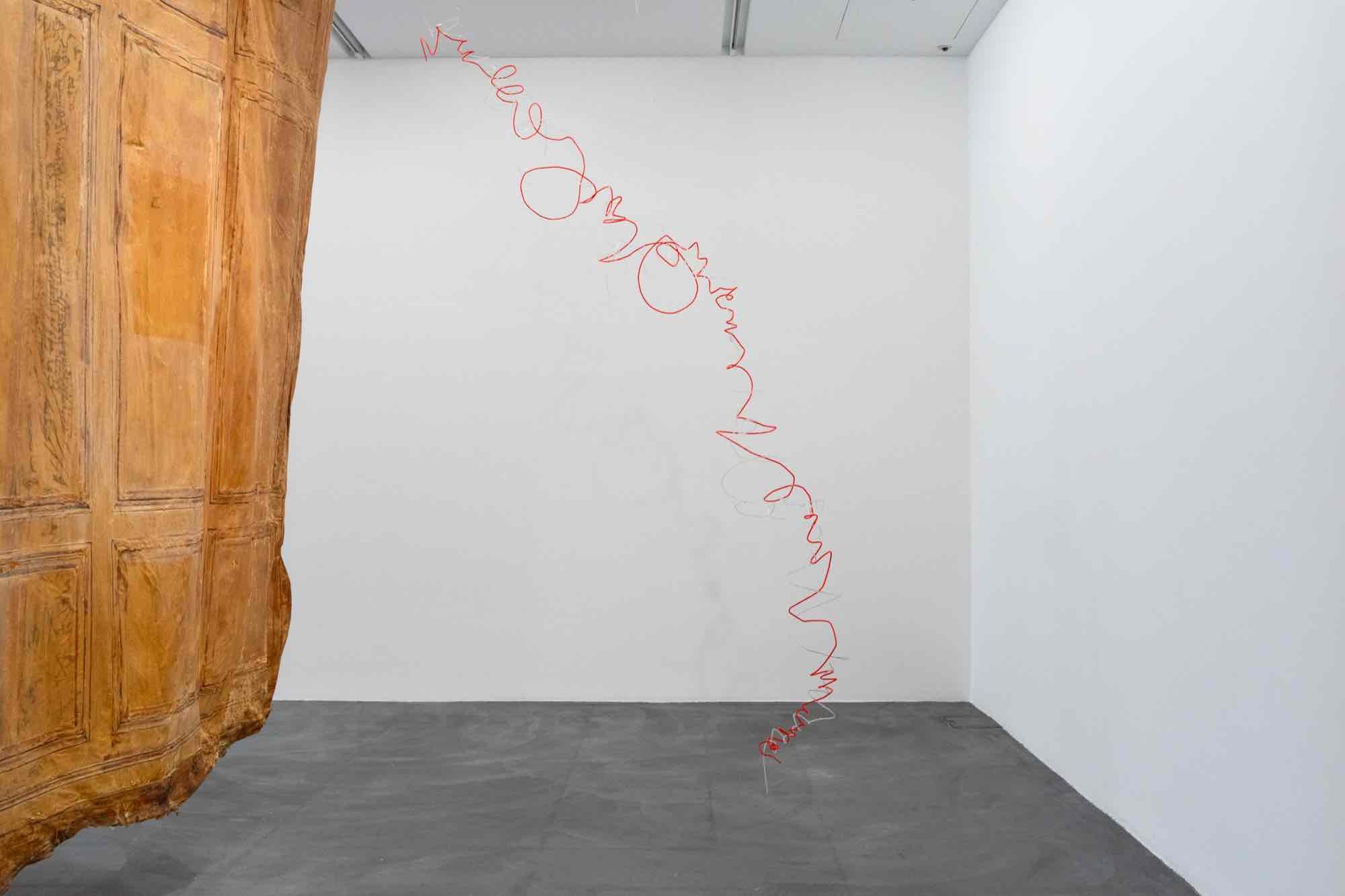
Exhibition view Berta Fischer, Untitled (red/clear), 2004, Heidi Bucher, Hautraum (Ricks Kinderzimmer, Lindgut Winterthur), 1987, gossamer, fish glue, latex, bamboo, wire. Sammlung Migros Museum für Gegenwartskunst. Photo: Studio Stucky, copyright Berta Fischer and The Estate of Heidi Bucher
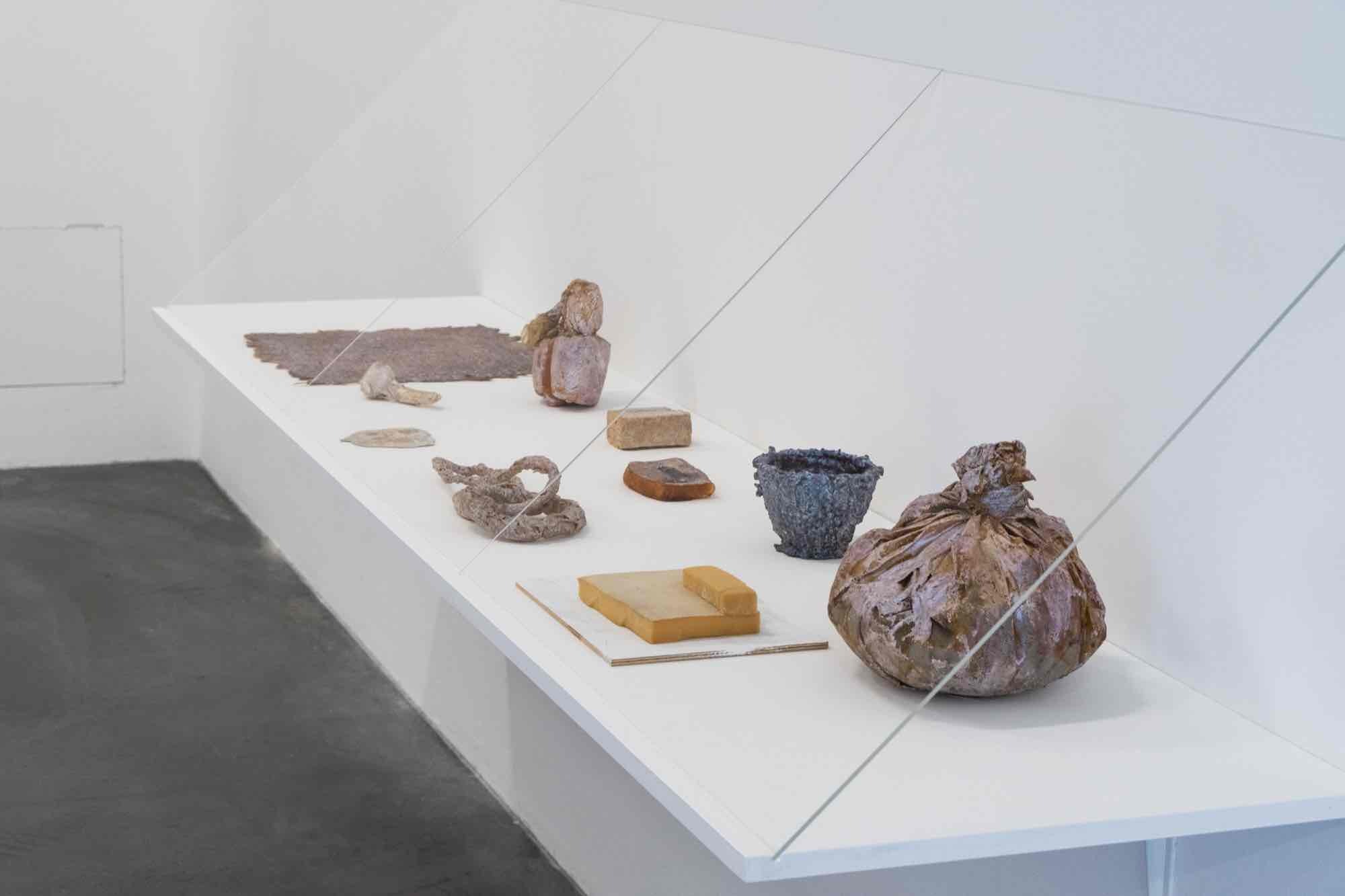
Heidi Bucher, Ohne Titel (Neun Objekte), 1972-1987, fabric, soap, tulle, foam, latex, mother-of-pearl pigment. Sammlung Migros Museum für Gegenwartskunst. Photo: Studio Stucky, copyright The Estate of Heidi Bucher
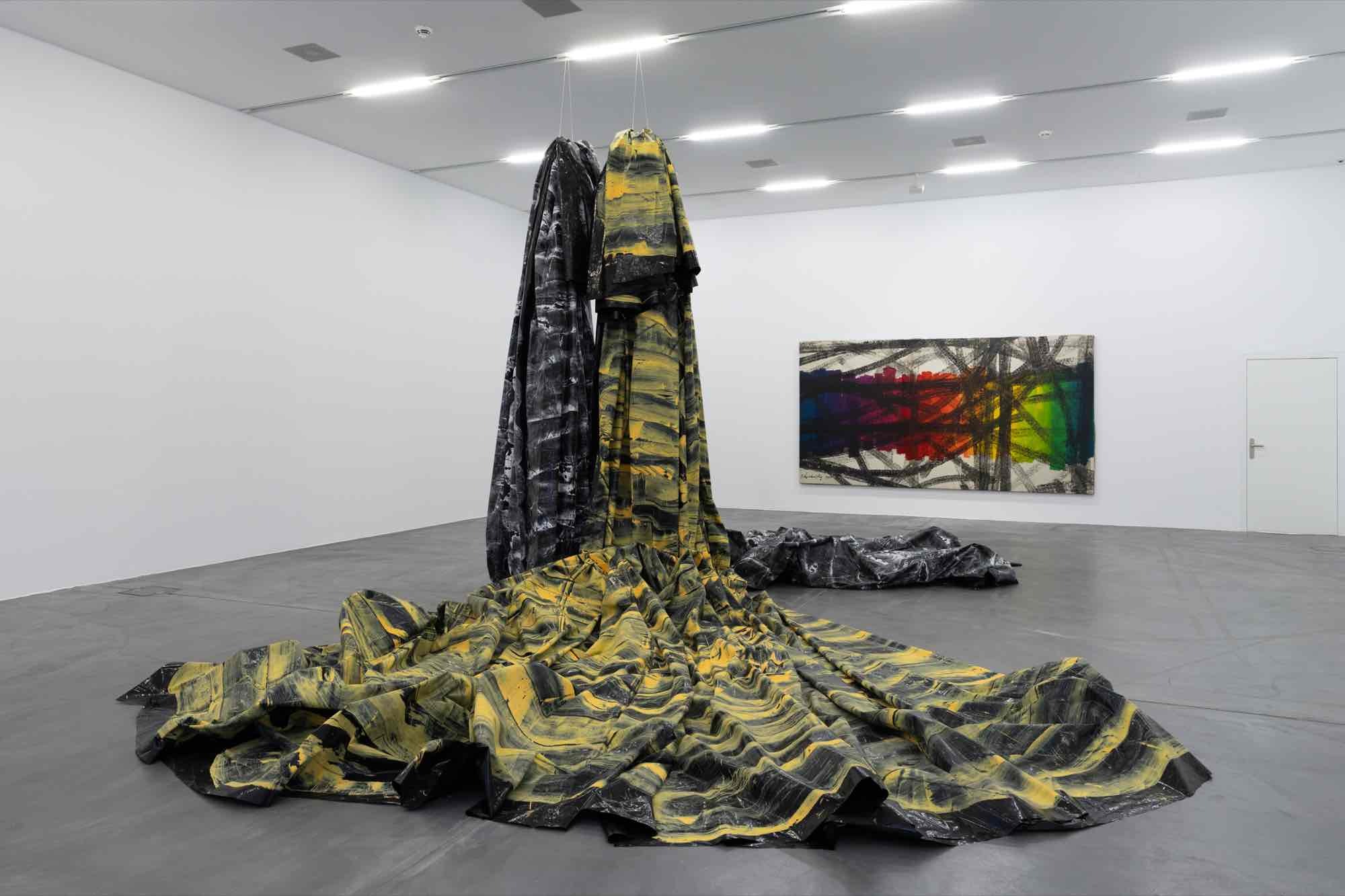
Exhibition view Sonia Kacem, Petra, 2013, Plastic sheeting, emulsion paint, nylon thread, Xanti Schawinsky, transition, 1960, oil on canvas. Sammlung Migros Museum für Gegenwartskunst. Photo: Studio Stucky, copyright Sonia Kacem and The Estate of Xanti Schawinsky

Exhibition view Sonia Kacem, Petra, 2013, Plastic sheeting, emulsion paint, nylon thread, Marion Baruch, Lasciar cadere, 2018, Polyestervlies, Pamela Rosenkranz, Death of Yves Klein, 2011, Single channel animation on Samsung flatscreen (color, sound) and Because They Tried to Bore Holes in my Greatest and Most Beautiful Work, 2012, Inkjet print, plexiglass, double-sided foil, bubbles. Sammlung Migros Museum für Gegenwartskunst. Photo: Studio Stucky, copyright Marion Baruch and Pamela Rosen- kranz

Exhibition view Marion Baruch, Lasciar cadere, 2018, Polyestervlies, Sonia Kacem, Petra, 2013, Plastic sheeting, emulsion paint, nylon thread. Sammlung Migros Museum für Gegenwartskunst. Photo: Studio Stucky, copyright Marion Baruch und Sonia Kacem
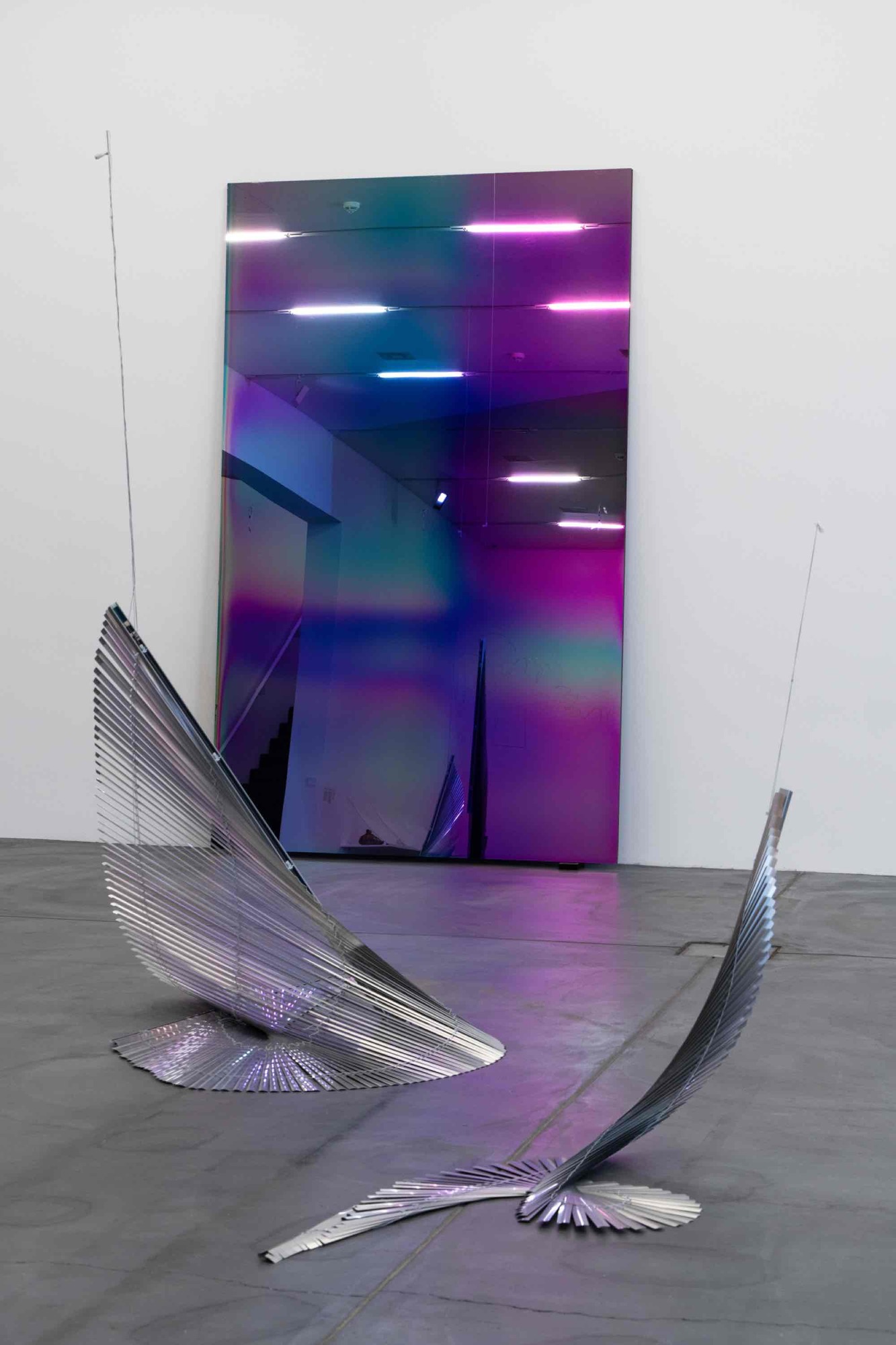
Exhibition view Martín Soto Climént, The Swan Swoons in the Still of the Swirl (Stills 1,2,3,4,5,6), 2010, single-channel video projection (color), blinds, Raphael Hefti, Sub- traction as Addition, 2015, Luxar coated, doubled glazed museum glas, Sammlung Migros Museum für Gegenwartskunst. Photo: Studio Stucky, copyright Martín Soto Climént, Raphael Hefti
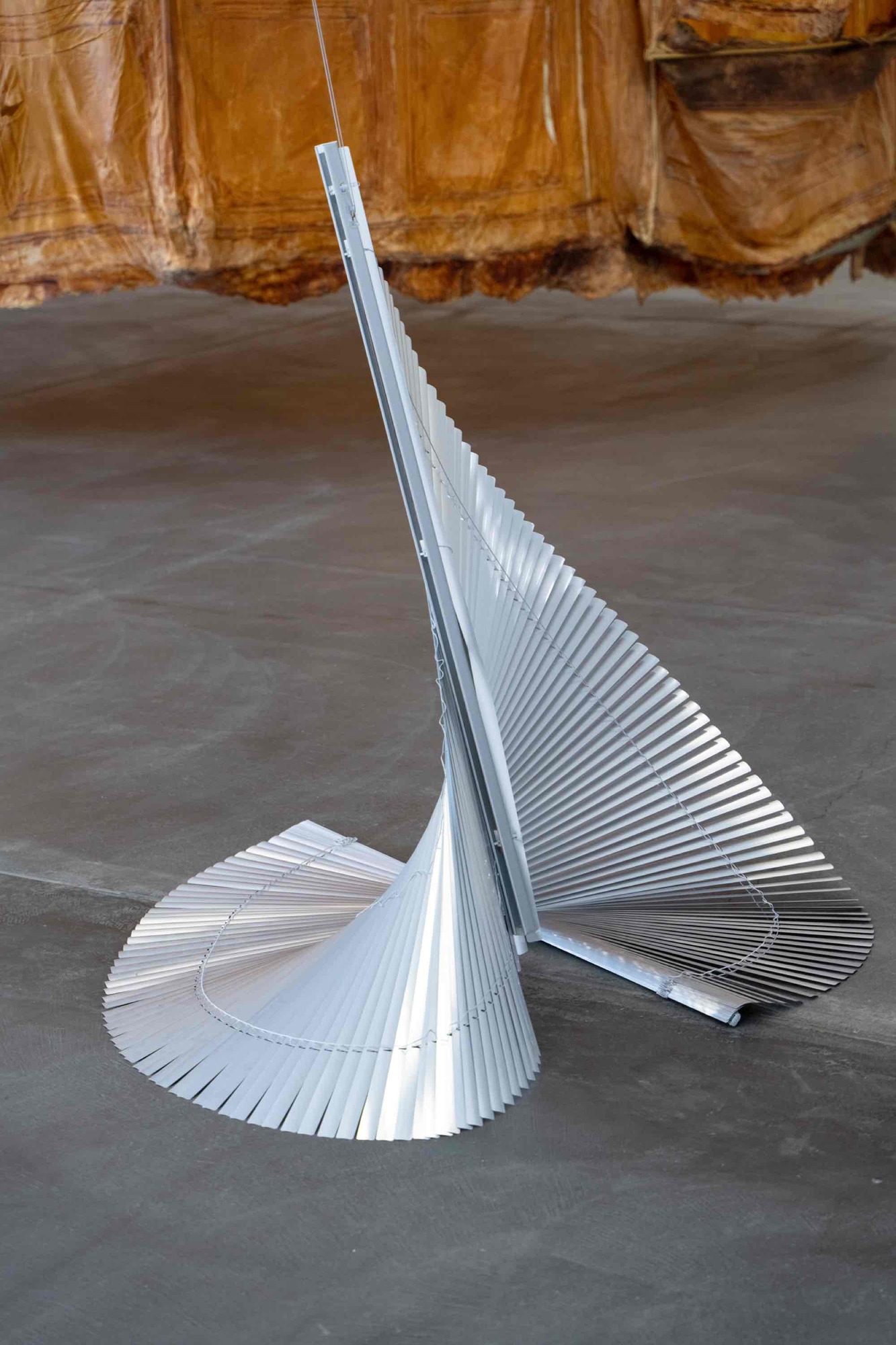
Exhibition view Martín Soto Climént, The Swan Swoons in the Still of the Swirl (Stills 1,2,3,4,5,6), 2010, single-channel video projection (color), blinds, Heidi Bucher, Haut- raum (Ricks Kinderzimmer, Lindgut Winterthur), 1987, gossamer, fish glue, latex, bam- boo, wire. Sammlung Migros Museum für Gegenwartskunst. Photo: Studio Stucky, copyright Martín Soto Climént and The Estate of Heidi Bucher
Chapter 2 – with works by Marion Baruch, Heidi Bucher, Martín Soto Climént, Thea Djordjadze, Berta Fischer, Raphael Hefti, Sonia Kacem, Pamela Rosenkranz and Xanti Schawinsky
Nothing is how it should be: stiff metal blinds hang from the ceiling in dance-like poses. The museum glass, usually non-reflecting, leans against the wall as an oversized sculpture, mirrored. Rigid acrylic glass floats in the room as a ball-like object. Contrasts form the starting point of this exhibition, at the heart of which lies material as an artistic resource and the aesthetic quality of the artworks. As the title Material Manipulations suggests, the latter arises from unconventional methods of treatment and experi- mentation with material.
The exhibition shows how artists test the properties of material: techniques are re-interpreted; chance prevails in experimental processing or materials and objects are used for purposes other than those intended. This extension of existing conventions in the creation of art can also be seen as the overcoming of what is already familiar – only in this way something new can emerge.
Since the 1960s artists have relied on impermanent or organic materials. For this, they like to work with materials from industry or integrate found objects into their works. Artistic working processes and techniques have long since been subject to constant change and expansion, too. However, unlike industrial processing – where the commercial usage of raw materials is governed by the conditions of mass production – no boundaries are set on the treatment of material in art.
As already the case in the first chapter, Material Memories, Heidi Bucher’s Hautraum (Ricks Kinderzimmer, Lindgut Winterthur) (1987) is the key work of the exhibition. Made of latex, the work serves with its specific materiality as a hinge between the two chapters: it is an object charged with memories and at the same time witness to an experiment in material. Early latex works by Bucher are also on show in Material Mani- pulations along with Hautraum. Here, the artist uses such mundane objects as cleaning rags or pieces of soap, which she has coated with liquid rubber and then covered with mother-of-pearl. At the same time, the objects are studies in material and can be seen as leading the way for Bucher’s later experimental works with rubber.
Other artists represented in the exhibition deliberately have their works made industrially and push existing production methods to their limits. Where do the physical boundaries of the material lie? Raphael Hefti, for example, has unbreakable museum glass treated with a chemical process that is actually meant to make the glass non-reflecting, but which is repeated so often that it reflects and shimmers with colourful light reflections. Thus, the usually ‘invisible’ museum glass is rendered visible, turning into an aesthetic object itself.
Material Manipulations also displays a sculpture made of glass by Thea Djordjadze that recalls a bench: the artistic use of the fragile material means that the promise of stability in seating furniture is no longer given; the object no longer fits its purpose. Is the newly created, non-functioning object even a critique of capitalistic notions of efficiency, which always takes top priority in industrial production?
At the heart of another installation is the experimental treatment of plastic foil. Sonia Kacem creates a monumental installation out of long plastic sheeting that she has tinted with acrylic paint. Petra’s folds falling luxuriantly, the space-filling work hangs in the exhibition room. Kacem borrowed the title from the famous ancient city of ruins in Jordan that is chiselled directly into the rock: fascinated by the way that art and architecture were hewn into the landscape here by removing material, Kacem continues with the draped plastic sheeting her interest in the threshold between figuration and abstraction, between landscape and sculpture.
The second chapter of the collection exhibition Material Manipulations unifies artistic positions that work with the most varied techniques. What they all have in common, however, is an unconventional use of materials and a curiosity for experimental treat- ment and exploration.
Curator: Nadia Schneider Willen
Nothing is how it should be: stiff metal blinds hang from the ceiling in dance-like poses. The museum glass, usually non-reflecting, leans against the wall as an oversized sculpture, mirrored. Rigid acrylic glass floats in the room as a ball-like object. Contrasts form the starting point of this exhibition, at the heart of which lies material as an artistic resource and the aesthetic quality of the artworks. As the title Material Manipulations suggests, the latter arises from unconventional methods of treatment and experi- mentation with material.
The exhibition shows how artists test the properties of material: techniques are re-interpreted; chance prevails in experimental processing or materials and objects are used for purposes other than those intended. This extension of existing conventions in the creation of art can also be seen as the overcoming of what is already familiar – only in this way something new can emerge.
Since the 1960s artists have relied on impermanent or organic materials. For this, they like to work with materials from industry or integrate found objects into their works. Artistic working processes and techniques have long since been subject to constant change and expansion, too. However, unlike industrial processing – where the commercial usage of raw materials is governed by the conditions of mass production – no boundaries are set on the treatment of material in art.
As already the case in the first chapter, Material Memories, Heidi Bucher’s Hautraum (Ricks Kinderzimmer, Lindgut Winterthur) (1987) is the key work of the exhibition. Made of latex, the work serves with its specific materiality as a hinge between the two chapters: it is an object charged with memories and at the same time witness to an experiment in material. Early latex works by Bucher are also on show in Material Mani- pulations along with Hautraum. Here, the artist uses such mundane objects as cleaning rags or pieces of soap, which she has coated with liquid rubber and then covered with mother-of-pearl. At the same time, the objects are studies in material and can be seen as leading the way for Bucher’s later experimental works with rubber.
Other artists represented in the exhibition deliberately have their works made industrially and push existing production methods to their limits. Where do the physical boundaries of the material lie? Raphael Hefti, for example, has unbreakable museum glass treated with a chemical process that is actually meant to make the glass non-reflecting, but which is repeated so often that it reflects and shimmers with colourful light reflections. Thus, the usually ‘invisible’ museum glass is rendered visible, turning into an aesthetic object itself.
Material Manipulations also displays a sculpture made of glass by Thea Djordjadze that recalls a bench: the artistic use of the fragile material means that the promise of stability in seating furniture is no longer given; the object no longer fits its purpose. Is the newly created, non-functioning object even a critique of capitalistic notions of efficiency, which always takes top priority in industrial production?
At the heart of another installation is the experimental treatment of plastic foil. Sonia Kacem creates a monumental installation out of long plastic sheeting that she has tinted with acrylic paint. Petra’s folds falling luxuriantly, the space-filling work hangs in the exhibition room. Kacem borrowed the title from the famous ancient city of ruins in Jordan that is chiselled directly into the rock: fascinated by the way that art and architecture were hewn into the landscape here by removing material, Kacem continues with the draped plastic sheeting her interest in the threshold between figuration and abstraction, between landscape and sculpture.
The second chapter of the collection exhibition Material Manipulations unifies artistic positions that work with the most varied techniques. What they all have in common, however, is an unconventional use of materials and a curiosity for experimental treat- ment and exploration.
Curator: Nadia Schneider Willen
